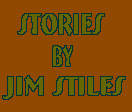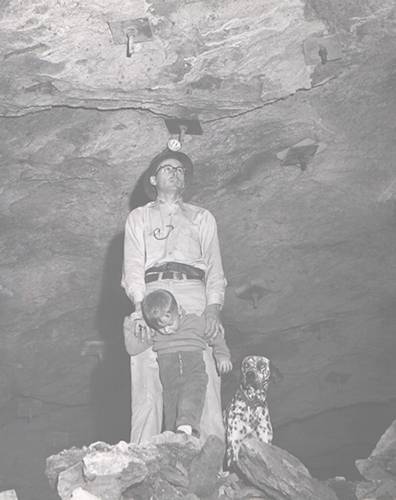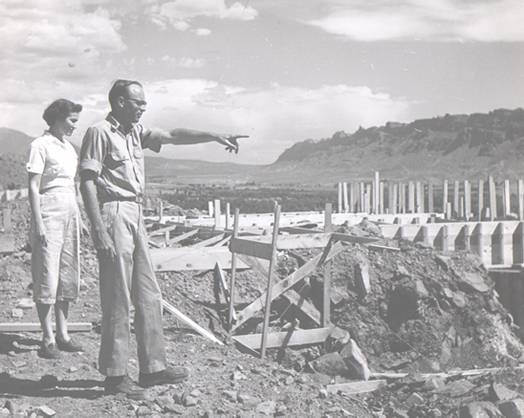

My father, Charlie Steen, has always maintained that the truth about his discovery of the Mi Vida mine and its consequences is a much better story than the fiction and half-truths that people insist on perpetuating. Despite the fact that his uranium discovery is one of the most publicized and well documented mineral discoveries in history, people can’t seem to resist the impulse to distort and rewrite history.
Unfortunately, this isn’t confined to bar-room reminiscences and tales told by old miners in rest homes. Articles about other peoples' roles in my father's discovery and observations by individuals who never met any of the players involved in the events of fifty years ago are now finding their way into print in historical publications. These accounts range from hard-luck stories about people who staked the Mi Vida ore body before my father, but couldn't raise the money to drill where they knew a fortune was awaiting them, to lies about grubstakers being cheated out of millions because they couldn't prove they had financed Charlie Steen’s prospecting activities.
Perhaps the most absurd of all of these revisionist discovery stories is the one that has my father's jeep-mounted drill breaking down two or three miles from his intended destination; and, since he couldn't go any further, he supposedly decided to drill for uranium where his rig had come to a halt. In this patently false version, Utah's premier uranium mining area owes its discovery more to mechanical failure than to human endeavor.
Although the Mi Vida uranium mine is recognized by mining historians and members of the mineral exploration business as one of the most important ore deposits found during the last century, most of the new residents of the area that felt the full impact of the Uranium Boom probably were not around when the rags to riches saga of Charlie Steen's successful search for a fortune in uranium touched off one of the greatest rushes in mining history. No town on the Colorado Plateau was more changed by one man's mine than Moab, Utah. Nothing has ever been the same as it was before Charlie Steen drilled into the Mi Vida uranium ore deposit and unlocked the location of over one-billion dollars worth of one of the most sought-after minerals in history.
Are the facts about Charlie Steen's discovery of the Mi Vida mine actually better than the fiction? After fifty years does anybody care to sort out the truth from the legend? Now that Moab is dependent on tourism and mountain bikers for its seasonal injection of economic life sustaining lucre, does anyone want to remember the decade of 1950s when Moab was the "Uranium Capital of the World?" Can Moabites today even imagine that people were once drawn to the Canyonlands Country in order to make money mining radioactive mineral deposits?
After all of these years, should more credit or blame be assessed against the man whose single-minded determination caused all those tons of tailings to be placed at the entrance of a town that now wants to be rid them. Are the tailings just an unsightly reminder of its history when Moab relied on mining rather than its scenery? Do people really care anymore about how my father found fame and fortune and earned his rightful place in history, or would they prefer to believe the last thing they read or heard from someone who wishes it had happened differently?
To me, it matters. Here's the way I remember it.
The Early Days
My father's journey to the fortune that he found beneath the Mi Vida claim group in San Juan County, Utah started in Texas, where he grew up amid the wildcatters who transformed the state.
Charlie Steen was born in 1919. His father was an oil prospector who made and lost a small fortune during the few years that he was married to my grandmother, Rosalie. According to my Dad, the only two things he got from his father were his name, Charles Augustus Steen, and a Dalmatian dog. My father and his sister, Maxine, were raised by a succession of stepfathers during the years when the Great Depression dampened the financial excitement of the oil booms, but he never forgot the years when prospecting paid the way.
Growing up dirt poor toughened my father and strengthened his independence. Determined to succeed, he worked his way through college with a series of odd jobs. During the summer months, he worked for the Chicago Bridge and Iron Company in Houston. After attending Tarleton College in Stephenville, Texas where he met my mother, Minnie Lee Holland (who preferred to go by her initials, M.L.), he transferred to the Texas College of Mines and Metallurgy in El Paso and received his degree in geology in 1943.
Poor eyesight and a slight frame prevented him from serving in the war, and he spent the next three years working for a major oil company as a petroleum geologist looking for possible oil structures in the jungle headwaters of the Amazon Basin in Peru.
After returning to this country, he married my mother and worked as a field geologist for the Stanolind Oil Company, until he was fired for insubordination after he argued with two of his bosses over the way they were directing his work. Their conclusion that "he was innately rebellious against authority" got him blackballed by the tightly managed oil companies.
It was the best thing that could have happened to him, because it freed him to go prospecting on his own account. My mother, who had also grown up poor in Sweetwater, Texas, but in a very strict household, was eager to share in his prospecting adventures. Dad spent two years trying to raise enough money to drill some oil and gas properties he believed in, but he needed at least $100,000 in order to wildcat for oil. He supported his growing family as a small-scale building contractor in Houston, remodeling kitchens, adding bedrooms and baths--saving money for a grubstake while he tried to interest people in backing his oil play.
Uranium and the Germ of an Idea
Since he couldn't raise the money to go wildcatting for oil, he cast about for some mineral that was in demand and that a man on a mighty slim shoestring might prospect for with a hope of big returns. He read an article in the "Engineering & Mining Journal" about the still-young uranium mining industry that was centered on the Four Corners area of the Colorado Plateau, and my father began to read everything he could find about the rare element. Uranium had literally burst upon the world with the detonation of three atomic bombs at the end of World War II.
CHARLIE STEEN at Big Indian with son Mark and Butch the Dog
Prior to the development of the atomic bomb, uranium was considered a pretty worthless element, with few uses aside from being a costly source of radium. The discovery of high-grade pitchblende, the primary uranium ore, in the Belgian Congo in the 1920s made the lower-grade, yellow carnotite ores of the Colorado Plateau uneconomic. Because these ores also contained vanadium, which is used to harden steel, there were several periods when the need for vanadium revived the region's small-scale mining industry. Uranium that was separated from the vanadium and discarded during the milling process was later used to make the first atomic bombs. With the advent of the atomic age and the subsequent arms race with the Soviet Union, the United States was forced to buy ninety percent of its radioactive materials from the Belgian Congo and Canada.
The country's need for uranium for national defense was so urgent that the government decided it had to stimulate domestic prospecting and production through an incentive program of guaranteed prices, discovery bonuses and development loans. The Atomic Energy Act of 1946 created the Atomic Energy Commission (the AEC), and the government initiated an extensive exploration program to find domestic sources of uranium. The AEC encouraged individuals and companies to increase production by more than doubling the price per pound for high-grade uranium ore to $31 and with a $10,000 bonus for the first man to produce 20 tons of ore assaying at least 20% uranium in the United States.
Hundreds of government geologists and mining engineers scoured the Western States, searching for enough uranium ore to feed the two uranium processing plants that were being operated under strict security and behind highly guarded enclosures. While this resulted in an increase in uranium production, almost all of the mines on the Colorado Plateau were located in the Morrison Formation and were relatively small-sized, shallow, and low-grade.
In decades of searching on the Plateau, prospectors had uncovered only three ore deposits amounting to as much as 100,000 tons of this much lower-grade ore, and there were scores of small mines that had been worked out and abandoned. Since few of these smaller ore deposits held more than 10,000 tons of ore rich enough to be mined at a profit, the outlook for a large-scale uranium industry seemed pretty bleak. These geologic and economic conditions discouraged most of the larger, well-established mining companies from even looking for uranium deposits. And, while there were dozens of local prospectors and miners in southwestern Colorado and southeastern Utah who were making a living off these smaller mines, nobody was making a fortune and no one had discovered a major ore body. Most of these prospectors were part-time uranium seekers who had gained their practical knowledge working in these small mines, or cowboys and sheepherders who were just about the only people who had penetrated one of the most desolate, unsurveyed areas left in the country.
Even though you could stake a mining claim on public land with four claim posts and a dollar, it cost real money to prospect and explore for ore. My grandmother, Rosalie Shumaker, mortgaged her home in Houston and contributed a thousand dollars to buy a small portable drill; and my mother's sister, Tera, talked her husband into loaning my father enough money for a second-hand jeep. By the time that my father set off on his quest for uranium in the summer of 1950, my parents were already raising my three older brothers and I was on the way. Dad drove the jeep and a 20 foot trailer to Dove Creek, Colorado; and a few weeks after I was born, my mother and brothers and I traveled with my grandmother to join my father while he searched for the uranium that would change all of our lives.
A Grubstake, a Dream, and a Theory
Charlie Steen began his search by studying the geology of the uranium deposits of the area. He couldn't afford to buy a Geiger counter, but Dad figured that unless he used his education and training as a geologist, he had no better chance than the other prospectors who spent their time walking the rim rocks looking for uranium outcroppings on the surface. Because most of the readily accessible uranium deposits that outcropped were already staked by the time Dad arrived on the scene, he began to look for the geologic conditions that would cause uranium to collect and concentrate in certain favorable locations where it could be discovered with a drilling rig.
During the time we lived near Dove Creek, my father became friends with Bob Barrett, a slightly prosperous pinto bean farmer who had a pretty strong case of uranium fever. He also became well acquainted with William R. McCormick, the owner of the Dove Creek Mercantile Store. Bill McCormick's honest, generous nature was combined with a very shrewd business sense, but he had a weakness for uranium prospectors and a fondness for the mining game.
The Steens lived on rice, beans, oatmeal, rabbit stew and venison from the deer that my father shot regardless of the season while he prospected and examined other people's properties for McCormick and Barrett.
On Christmas Day, we moved to the Yellow Cat Wash area south of Cisco, where Dad staked some claims and drilled out a small uranium deposit on the promise of an interest in anything he found from a mining engineer who later reneged on his agreement. Somehow my parents managed to get by with small advances from my grandmother and loans from friends that didn't average $70 a month.
Early in 1951, Bill McCormick introduced Dad to Dan Hayes and Donald Adams, two local prospectors and mine owners who had been involved in uranium mining for many years. Hayes and Adams owned the 14 Big Buck claims that had been staked in 1948 to cover a meager exposure of oxidized uranium in the Cutler Formation on the southwestern flank of the faulted Lisbon Valley anticline in the Big Indian mining district of San Juan County, Utah. The Morrison Formation had been eroded off this upthrown portion of the anticline, and there were only three small uranium mines located in the entire district. These mines had produced a little more than 2,000 tons of low-grade uranium ore from host rocks in the Cutler Formation. The nearest producing uranium mine was more than twenty miles away from the Big Buck claim group.
All of the AEC and company geologists who had examined the area had written off the Big Indian mining district as an important potential source of uranium by the time Charles Augustus Steen was attracted to the area. There were simply too many better places to explore for uranium on the Colorado Plateau than a mining district that was missing the most important host rocks (the Morrison Formation) to waste much time or any money on the Big Indian mining district.
After examining the geology of the uranium bearing formation that Hayes and Adams had exposed with four short mine adits and bulldozer cuts along the rim, my father hiked above the Big Buck mine and began his geologic reconnaissance. As he walked and climbed over the rock formations, he began to formulate a theory that the lower grade exposures of uranium in the Cutler Formation would be enriched or concentrated down dip from the outcrops along the escarpment overlooking Big Indian Wash. The terrain was very rugged and without a single road into the country behind the Big Buck claims.
Dad noticed that the crest of the Lisbon Valley anticline was situated just about the same spot where he had hiked in above the rim, and he figured that any uranium that was concentrated down dip would be found in thicker deposits on this part of the anticlinal structure. He also saw that a large section of the upper rock formations had been removed by erosion, and knew that he would not have to drill through more than three hundred feet of the Wingate sandstone in order to prove his geologic theory.
After spending less than a day examining the rock formations and considering the geology of the area, Dad decided to stake the ground back of the Big Buck claims. Because of the rough nature of the ground and the fact that there were areas with hundreds of feet of air between the places where my father was marking the boundaries of his claims it was very slow going. Working alone, using his Brunton compass and pacing off the 600 by 1500 foot claims, Dad didn't encounter any signs that the ground had ever been staked by anyone else.
After this ground became some of the most valuable land in the county, there were several extensive title searches completed for legal reasons, and they didn't disclose any prior locations. At the end of several weeks, Charlie Steen had staked 11 mining claims: the Mi Vida, Linda Mujer, Mi Amorcita, Mi Alma, Bacardi, Te Quiero, Fundadoro, Pisco, Besame Mucho, Mi Corozan, and the Mujer Sin Verguenza. Another claim, the Ann, was staked later. Most of these mining claims were named after Spanish expressions contained in popular songs that Dad had heard in Peru. The Mi Vida claim literally means "My Life" in Spanish, but it actually means much more when it is used in the context of expressing one’s feelings towards a woman. Never was a mining claim more aptly named than the Mi Vida.
Charlie Steen filed his claims with the County Recorder in Monticello on March 7, 1951. Now that he had located his prospect, Dad had to convince someone to back his belief that uranium could be found beneath his claims, because the ore horizon was at least 200 feet below the surface and his portable drill could barely penetrate 50 feet. His theory was ridiculed and criticized by AEC geologists who were familiar with the country, and company geologists figured that they knew more about uranium ore deposits than some newcomer from Texas. The fact all the experts unanimously agreed on, that the Big Indian country was worthless, only stiffened my father's determination to prove them all wrong.
Dead Broke and The Dream on Hold (for a moment)
By this time the Steens were dead broke, so we moved to Tucson, where Dad worked as a carpenter and scraped together a small grubstake for another shot at prospecting. All the time he was in Arizona, Dad knew that he had to do his assessment work on his Big Indian claims or lose them by default. With my mother's encouragement, Dad turned down a job offer to work as a petroleum geologist, sold the trailer for $375, piled everything we owned on top of the jeep and headed back to Cisco, where we moved into a $15 a month tarpaper shack.
Bill McCormick came through with a beat-up, second-hand drilling rig and enough money to bulldoze four miles of rough road into the heart of the Mi Vida claim. Rosalie Shumaker sold her furniture for $1700 and came to Utah with a friend named Douglas Hoot to help her son find his fortune. Dad set the drill up as far down dip as possible and began drilling on July 3, 1952. After three days of drilling, at a depth of 73 feet, they started bringing up a grayish-black core that resembled coal. Dad and Hoot drilled through 14 feet of this unusual formation and my father set it aside to examine later. Three weeks later, on July 27, the drill bit suddenly broke off the drill stem at a depth of 197 feet---only three feet short of my father's goal. No yellow carnotite had been encountered.
THE FUTURE: Charlie & M.I. plan their hillside home about Moab, barely a year after their Discovery.
Just about beaten from frustration, Dad drove the 100 miles to Cisco with the intention of going directly on to Grand Junction to get some tools to fish out the broken bit. He remembered to bring along several samples of the grayish-black core, and when he got to Cisco he drove straight to Buddy Cowger's service station to gas up on credit. Buddy was also a prospector and a good friend. Like practically every uranium prospector on the Colorado Plateau except for Charlie Steen, Buddy owned a Geiger counter; and he was examining some samples when Dad pulled up. Impatient to be on his way, my father said, "Hell, I've got some stuff that'll do better than yours." When my Dad placed a piece of the grayish-black core next to the Geiger counter the needle leaped out of sight and the counter went crazy.
In a flash Charlie Steen realized that he had cored through 14 feet of pitchblende, one of the primary ores of uranium. Until July 6, 1952, nobody had ever found pitchblende on the Colorado Plateau, and my Dad had only seen specimens in museums, but he knew that the hole had finally come in for the Steen family. Dad whirled around and started running towards the shack where Mom was waiting for news from the Big Indian. After hitting her clothesline, he burst in the shack yelling: "We've hit it! We’ve hit it! It's a million dollar lick!" My father grabbed my mother and together they celebrated the discovery of the Mi Vida mine without knowing how profoundly their lives were about to change.
In the next installments of this series, I'll relate the history of the Mi Vida mine’s development, the formation of Utex Exploration Company and Standard Uranium, the exploration and exploitation of the Big Indian mining district, the disputes, the claim jumpers, the million dollar lawsuits and the struggle to construct the Uranium Reduction Company mill in boomtown Moab, the "Uranium Capital of the World." MS









